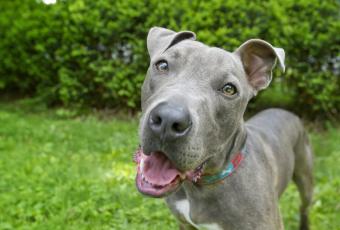
Did you know the "pit bull" isn't actually a breed but rather a group of breeds? There are several breeds that are often referred to as pit bulls. These breeds include the bull terrier, American bully, American pit bull terrier, American Staffordshire terrier, Staffordshire bull terrier, and American bulldog.
This is why dog rescuers often refer to "pit bull-type dogs" or "bully breeds" instead of "pit bulls" because no single breed is actually a "pit bull."
Bully Breeds and Danger — Or Lack Of

Bully breeds are stereotypically thought to be more dangerous than other breeds. This stereotype was developed due to their role in dog fighting, but it's important to understand that this has just as much (or more) to do with the owner as the dog. They became good at dog fighting due to their level of loyalty to their pet parents.
Like any breed, bully breeds have the potential to be wonderful, loving pets. Their loyalty, when directed positively, can be one of their greatest strengths. The key to unlocking their gentle, affectionate nature lies in proper socialization and training. When raised in a loving, caring environment and given the right guidance and social experiences, these dogs can be just as friendly, safe, and sociable as any other breed. As with any breed, some adult pit bull-type dogs may prefer not to be around other adult dogs.
Pit bull lovers often refer to their dogs as "pibbles." According to Urban Dictionary, Pibbling includes "exuberant canine silliness, as perfected by pit bull type dogs."
You NEED to See the Pibble Smile

Pit bull-type dogs are known for their irresistibly charming smiles. When they grin, it's like a burst of sunshine, complete with a display of happy eyes and a wagging tail. Their smiles are so full of joy and warmth that they can easily melt hearts and bring a smile to anyone's face.
Their expressive faces, often coupled with a playful and friendly demeanor, make their smiles especially endearing. It's not just about showing their teeth — it's the whole package of their cheerful expression, the excitement in their eyes, and the enthusiastic tail wag that often accompanies their grins.
Pit Bulls Aren't for Everyone

Pit bull breeds, known for their vivacious and spirited nature, might not be the ideal fit for every pet owner. Their high energy levels mean they require a lot of exercise, play, and mental stimulation. This boundless energy makes them great companions for active individuals or families who love spending lots of time outdoors and engaging in physical activities.
For those who prefer a more laid-back lifestyle or don't have the time for frequent and vigorous exercise, a bully breed might be a bit too much to handle.
Bully Breeds Are Determined

Pit bull-type breeds are often known for their remarkable determination. Give them a task or a job, and they're like furry little superheroes, not resting until their mission is accomplished. This tenacity makes them quite trainable — they're like eager students in a classroom, always ready to learn and impress.
Their stubborn streak, while sometimes a bit challenging, is also a sign of their dedication and loyalty. It's what makes them excellent at activities like agility training, obedience, or even more specialized jobs. But it also means that training them requires a blend of patience, consistency, and a good understanding of what motivates them.
In the mood for a great underdog story? Check out Wallace by Jim Gorant, the true story of a shelter pit bull who went from nearly being euthanized to becoming a world-champion disc dog.
Pit Bull Owners Need to Be, Too

Unfortunately, pit bull-type breeds often face a tough situation because of widespread negative stereotypes. They're like a book that gets judged based on the cover instead of taking a moment to look at the magic inside. In some places, these breeds are straight-up not allowed — it's as if they have an invisible 'Not Welcome' sign hanging around their necks.
Even in areas where these breeds aren't banned, owning one can mean your wallet feels the pinch. That's right, we're talking about homeowners insurance. For houses with bully breeds, insurance can get pricier, or in some cases, it might be hard to get coverage at all. It's a bit like your insurance company saying, “Oh, you have a pit bull? That's going to cost you extra!” It's not exactly fair, especially when these dogs can be just as loving and well-behaved as any other breed.
State Farm offers insurance to all pet owners, no matter the breed.
Pit Bulls Were Originally Known As Nanny Dogs

Bully-type breeds are commonly referred to as "nanny dogs" by those who know them. They have a unique knack for children and tend to be very gentle with the kiddos in their families. They're always ready to watch over the children with a wagging tail and a friendly lick.
These dogs are basically big bundles of love. Plus, they're super loyal — they stick by their little human friends through thick and thin, always ready to give a comforting nuzzle or a protective bark.
Bully Breeds Are Heroes in War: Sergent Stubby

Pit bull-type dog breeds have a distinguished history of serving as soldiers and mascots in wartime, showcasing their bravery and loyalty. A prime example is Stubby, an extraordinary pit bull who served during World War I. Stubby's remarkable service and acts of valor, like rescuing his regiment from mustard gas attacks, truly set him apart.
Upon returning home, Sergeant Stubby was celebrated as a hero, receiving a hero's parade. His story is a testament to the courage and capability of pit bulls in roles that demand intelligence, bravery, and loyalty. Stubby's legacy goes beyond his military achievements; he became a symbol of the breed's potential for greatness and the strong bond that can exist between humans and dogs in the most challenging circumstances.
According to National Geographic, Stubby's heroic actions were so outstanding that he was promoted to the rank of Sergeant, an honor rarely bestowed upon a dog.
Red Nose vs Blue Nose American Pit Bull Terrier

The blue nose and red nose American pit bull terriers, as indicated by their names, have distinct physical traits centered around the color of their nose and coat. These color variations are the result of recessive genes inherited from their parents.
Blue nose American pit bull terriers are characterized by their unique grayish or charcoal-colored noses, often accompanied by a coat of a similar gray shade. On the other hand, red-nosed American pit bulls are notable for their reddish or pinkish noses, usually paired with red or auburn fur.
Shelters Are Overflowing With Bully Breeds

Animal shelters across the country are facing a significant challenge with an overwhelming number of pit bull-type dog breeds flowing in. These breeds are among the most common in shelters, and unfortunately, their numbers are so high that many of these dogs struggle to find forever homes.
These shelters often lead to a heartbreaking reality: due to space and resource constraints, many of these dogs are at risk of being euthanized.
Factors contributing to this problem include a lack of spaying and neutering, abandonment, and the aftermath of breeding practices focused on specific traits rather than the health and well-being of the animals.
Originally Bred to Be Work Dogs

Pit bull-type breeds originally come from England, where they were bred in the 19th century by crossing bulldogs with terriers to combine strength and agility. They were used for a variety of tasks, including guarding, hunting, and farming. Their strength and determination made them valuable working dogs who were loyal, determined, and protective.
Help In The Fight For Awareness

If you have one of the five bully breeds and you adore them to pieces, advocates sure could use some help raising public awareness. The public needs to know the truth about these breeds to separate the myths from the facts.
According to the American Kennel Club, "In the United States, more than 700 cities have enacted BSL, affecting thousands of dogs across the country, in addition to the many breeds affected worldwide. Enforcing laws that punish “the deed, not the breed” ensures that communities stay safe and individuals can enjoy their choice of breed and the best pet for their lifestyle."
Sign up for our newsletter featuring all the latest stories and products we love.
Pit Bull-Type Dogs Are All Sizes

Pit bull-type dogs display a wide range in size, with their weight varying from a modest 30 pounds to a more robust 90 pounds. A notable aspect of their appearance is their muscular build, which can give the impression that they are larger than their actual weight would suggest.
This muscularity, combined with their solid, athletic frame, often makes them appear intimidating even though most are big, human-loving babies.
Average Lifespan and General Health

Bully breeds typically enjoy a lifespan of around 12 to 14 years, offering their owners many years of companionship. Generally, these dogs are robust and healthy, but they do have a predisposition to certain health conditions, particularly those related to their hearts. Some of the common heart conditions seen in these breeds include mitral valve disease, septal defects, pulmonic stenosis, and subaortic stenosis.
Apart from heart issues, bully breeds often tend to be susceptible to skin irritations. This sensitivity can be triggered by parasites, such as fleas or mites, over-grooming habits, or allergies to various environmental factors or foods. Managing these skin conditions requires careful attention to their grooming, diet, and environment to ensure they stay comfortable and healthy.
Pit Bull Exercise Requirements Are Manageable to Most

Even though pit bull-type breeds are known for their boundless energy, they usually require just around 45 minutes to an hour of intense exercise daily to stay happy and healthy. But it's worth noting that during this exercise period, it might seem like they're unleashing all their energy in one go — often in the form of what many pet owners affectionately call 'wild zoomies.'
This is when they run around with seemingly endless enthusiasm and speed, which is not only a joy to watch but also an excellent way for them to burn off their abundant energy.
Plan out some activities you can do inside to keep these pups busy even on rainy days.
They Can Have a High Prey Drive

These pups have a high prey drive, which means they are one of those dogs with the "squirrel!" complex. If they see a squirrel, there's a huge chance they'll be off to the races. Since they're like this with the smaller critters outside, as you can expect, they may not be suitable for homes with cats or small animals unless they've been raised with them.
If they're raised with cats from a young age, they may be perfectly fine with them and learn to associate them with love and cuddles.
Picking a Bully Breed

Although all the pit bull-type dogs are in the same grouping, that doesn't mean that every one is exactly the same. They're still different breeds, and every dog is an individual with their own special gifts and personalities.
If you're interested in adopting one from a shelter, do some more digging into the individual dog breeds and their traits before visiting them with a shelter member. And, like all other dog breeds, it's important to get to know each dog on their own before making your choice. Even dogs within the same breed can be different from one another.







